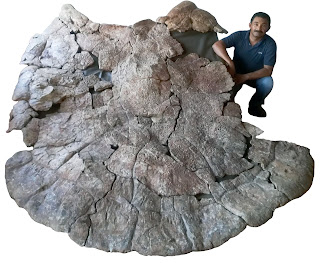Well, Melaina, the Earth’s mass does decrease when fossil fuels are burnt. But not in the sense you were probably imagining, and only to a very, very small degree.
There is no decrease in chemical mass. Burning fossil fuels rearranges atoms into different molecules, in the process releasing energy from chemical bonds, but in the end, the same particles — protons, neutrons, and electrons — remain, so there is no decrease in mass there.
But energy is released, and some of that energy is radiated out into space, escaping from the Earth entirely. Einstein's Theory of Relativity tells us that energy does have mass: E=mc^2, or m=E/c^2. When a chemical bond that stores energy is formed, the resulting molecule has a very tiny bit more mass than the sum of the masses of the atoms from which it was formed, so a net gain. Wait, what?
Again, this is an exceedingly tiny bit. In very rough numbers, worldwide energy consumption is about 160,000 terawatt-hours per year, and about 80% of that comes from fossil fuels. That is about 450,000,000 TJ/year (tera-joules/year). The speed of light is 300,000,000 meter/s; dividing 450,000,000 TJ by (300,000,000 m/s)^2 gives a decrease in mass of 5000 kilograms per year.
That is an exceedingly small fraction — 50 billionths of one percent — of the approximately 10,000,000,000,000 kilograms of fossil fuels consumed per year. And as far as making the Earth lighter, it’s a tenth of a billionth of a billionth of a percent of the Earth’s mass.
Of course, the energy in fossil fuels originally came from the Sun, and in absorbing that sunlight the Earth’s mass increases slightly. I picture the Earth expanding and contracting, taking a deep breath, then exhaling. We don't see this when we look, but it is a great visual for imaging this never-ending give and take process. I'm not sure how we'd measure the small changes to the Earth's net mass on any given day. The mass of the Earth may be determined using Newton's law of gravitation. It is given as the force (F), which is equal to the Gravitational constant multiplied by the mass of the planet and the mass of the object, divided by the square of the radius of the planet.
Newton's insight on the inverse-square property of gravitational force was from an intuition about the motion of the earth and the moon. The mathematical formula for gravitational force is F=GMmr2 F = G Mm r 2 where G is the gravitational constant. I know, Newton’s law could use some curb appeal but it is super useful when understanding what keeps the Earth and other planets in our solar system in orbit around the Sun and why the Moon orbits the Earth. We have Newton to thank for his formulas on the gravitational potential of water when we build hydroelectricity dams. Newton’s ideas work in most but not all scenarios. When things get very, very small, or cosmic, gravity gets weird... and we head on back to Einstein to make sense of it all.
There was a very cool paper published yesterday by King Yan Fong et al. in the journal Nature that looked at heat transferring in a previously unknown way — heat transferred across a vacuum by phonons — tiny, atomic vibrations. The effect joins conduction, convection and radiation as ways for heating to occur — but only across tiny distances. The heat is transferred by phonons — the energy-carrying particles of acoustic waves, taking advantage of the Casimir effect, in which the quantum fluctuations in the space between two objects that are really, really close together result in physical effects not predicted by classical physics. This is another excellent example of the universe not playing by conventional rules when things get small. Weird, but very cool!
But the question was specifically about the mass of the Earth and the burning of fossil fuels, and that process does decrease the mass.
So it is mostly true that the Earth’s mass does not decrease due to fossil fuel burning because the numbers are so low, but not entirely true. The fuel combines with oxygen from the atmosphere to produce carbon dioxide, water vapour, and soot or ash. The carbon dioxide and water vapour go back into the atmosphere along with some of the soot or ash, the rest of which is left as a solid residue. The weight of the carbon dioxide plus the water vapour and soot is exactly the same as the weight of the original fuel plus the weight of the oxygen consumed. In general, the products of any chemical reaction whatsoever weigh the same as the reactants.
There is only one known mechanism by which Earth’s mass decreases to any significant degree: molecules of gas in the upper atmosphere (primarily hydrogen and helium, because they are the lightest) escape from Earth’s gravity at a steady rate due to thermal energy. This is counterbalanced by a steady rain of meteors hitting Earth from outer space (if you ever want to hunt them, fly a helicopter over the frozen arctic, they really stand out), containing mostly rock, water, and nickel-iron. These two processes are happening all the time and will continue at a steady rate unchanged by anything we humans do. So, the net/net is about the same.
So, the answer is that the Earth's mass is variable, subject to both gain and loss due to the accretion of in-falling material (micrometeorites and cosmic dust), and the loss of hydrogen and helium gas, respectively. But, drumroll please, the end result is a net loss of material, roughly 5.5×107 kg (5.4×104 long tons) per year.
The burning of fossil fuels has an impact on that equation, albeit a very small one, but an excellent question to ponder. A thank you and respectful nod to Les Niles and Michael McClennen for their insights and help with the energy consumption figures.

































